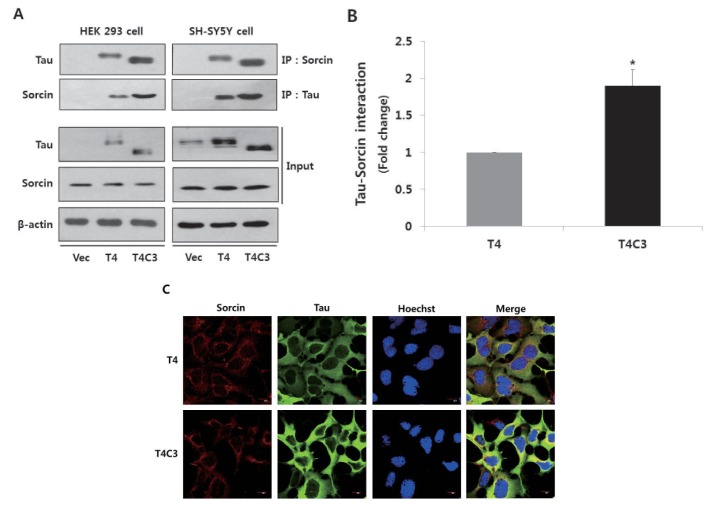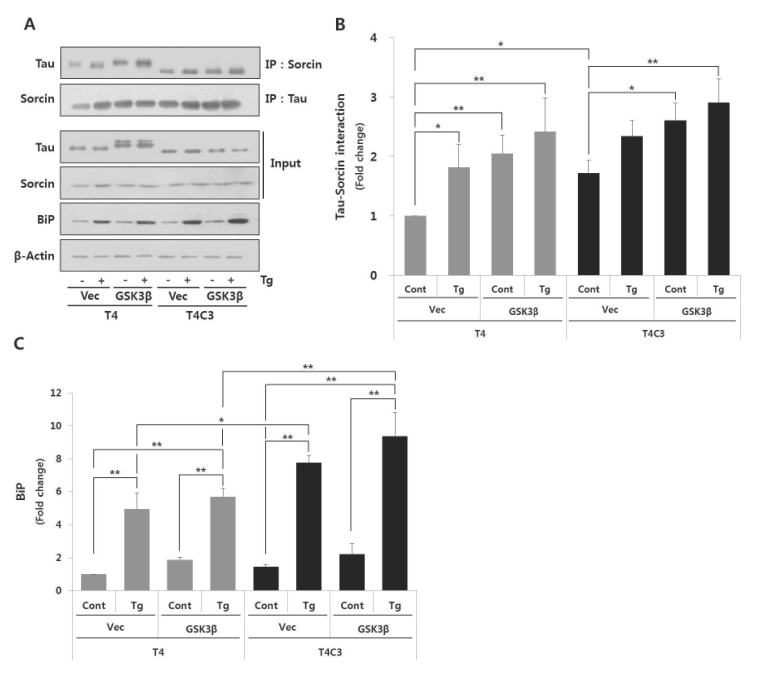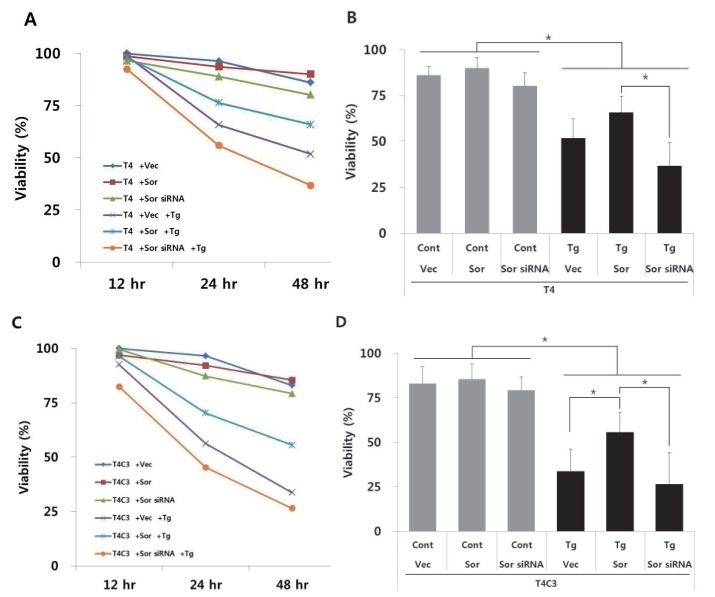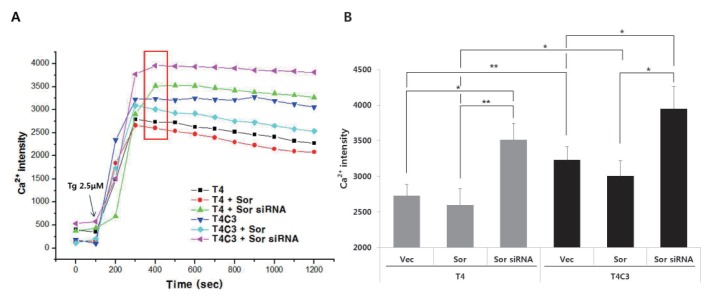INTRODUCTION
METHODS
Plasmid constructs
Cell culture
Transient Transfections of plasmid DNA and siRNA, and drug treatment
Immunoblotting
Immunoprecipitation
Immunocytochemistry
Measurement of intracellular Ca2+ levels
Statistical analysis
RESULTS
Tau interacts with sorcin and expression of caspase-3-cleaved tau potentiates tau-sorcin interaction
 | Fig. 1Tau interacts with sorcin.Representative images (A) and quantitative analysis (B) of immunoprecipitation of tau and sorcin. Intracellular localization of tau and sorcin (C). HEK 293 and SH-SY5Y cells were transfected with T4, T4C3, or vector. After 48 hr of transfection, cells were harvested. Cell lysates were immunoprecipitated with tau or sorcin antibody, and detected with Western blotting with respective antibodies. Vector was used for transfection control and agarose beads control in immunoprecipitation data to conform binding of agarose beads to tau or sorcin. Data were obtained from independent experiments (n=3) and expressed as mean±SD. *p<0.05 indicates significant differences between the indicated groups. To examine the intracellular localization of tau and sorcin, T4 or T4C3 transfected HEK 293 cells were stained with sorcin (red) or tau (green) antibody. Nuclei were visualized by Hoechst staining (blue). Scale bar 10 µm. Vec stands for vector (pcDNA3.1-) and IP for immunoprecipitation.
|
Phosphorylation of tau by GSK3β and ER stress by thapsigargin potentiate interaction of tau with sorcin
 | Fig. 2Fibrillogenic tau species preferentially associates with sorcin and increases ER stress induced by thapsigartin compared to wild type tau.Immunoprecipitation of tau and sorcin (A). Quantitative analyses of Tau-sorcin interaction (B) and bip expression (C). HEK 293 cells were co-transfected T4 or T4C3 with GSK3β-S9A or vector, respectively. After 48 hr of transfection, cells were treated 2.5 µM thapsigartin for 24 hr to induce ER stress. Cell lysates were immunoprecipitated with tau or sorcin antibody, and performed Western blotting. BiP was used as an ER stress maker. Data were obtained from independent experiments (n=3) and expressed as mean±SD. *p<0.05 and **p<0.01 indicate significant differences between the indicated groups. Vec stands for vector (pcDNA3.1-), cont for control, Tg for thapsigargin, and IP for immunoprecipitation.
|
Expression of caspase-3-cleaved tau increases thapsigargin-induced cytotoxicity
 | Fig. 3Expression of caspase-3 cleaved tau and knock-down of sorcin increase thapsigartin-induced cytotoxicity but over-expression of sorcin decreases thapsigartin-induced cytotoxicity.HEK293 cells were transiently transfected with T4 (A, B) or T4C3 (C, D) constructs in the absence or presence of sorcin overexpression or sorcin siRNA. After 48 hrs of transfection, cells were treated 2.5 µM thapsigartin. Cell viability was measured with MTT assay (A, C) and statistical analyses of cell viability were determined at 48 hr after thapsigartin treatment (B, D). Data were obtained from independent experiments (n=3) and expressed as mean±SD. *p<0.05 and **p<0.01 indicate significant differences between the indicated groups. Vec stands for vector (pcDNA3.1-), Sor for sorcin, Cont for control, and Tg for thapsigargin.
|
Overexpression of sorcin attenuates thapsigargin-induced apoptosis whereas knock-down of sorcin accelerates thapsigargin-induced apoptosis
 | Fig. 4Overexpression of sorcin significantly attenuates thapsigartin-induced apoptosis in T4C3 cells.Representative immunoblots (A) of examined proteins and quantitative analyses of cleaved PARP (B) and cleaved caspase-12 (C). HEK293 cells were transiently transfected T4 or T4C3 constructs and then co-transfected with sorcin or vector, respectively. After 48 hrs of transfection, cells were treated 2.5 µM thapsigartin for 24 hr. Western blotting was carried out with cleaved PARP and cleaved caspase-12 antibodies to determine role of sorcin on thapsigartin-induced apoptosis. Data were obtained from independent experiments (n=3) and expressed as mean±SD. *p<0.05 and **p<0.01 indicate significant differences between the indicated groups. Vec stands for vector (pcDNA3.1-), Sor for sorcin, Cont for control, and Tg for thapsigargin.
|
 | Fig. 5Knock-down of sorcin significantly accelerates thapsigartin-induced apoptosis in T4 cells.Representative immunoblots (A) and quantitative analyses of cleaved PARP (B) and cleaved caspase-12 (C). HEK293 cells were transiently transfected T4 or T4C3 constructs and then co-transfected with sorcin siRNA or control siRNA, respectively. After 48 hr of transfection, cells were treated with 2.5 µM thapsigartin for 24 hr. Western blotting was carried out with cleaved PARP and cleaved caspase-12 antibodies to determine role of sorcin on thapsigartin-induced apoptosis. Data were obtained from independent experiments (n=3) and expressed as mean±SD. **p<0.01 indicates significant differences between the indicated groups. Vec stands for vector Sor for sorcin, Cont for control, and Tg for thapsigargin.
|
Expression of caspse-3-cleaved tau and silencing of sorcin potentiate the thapsigargin-induced perturbation of intracellular calcium homeostasis
 | Fig. 6Expression of caspse-3-cleaved tau and silencing of sorcin potentiate the thapsigargin-induced perturbation of intracellular calcium homeostasis.Representative image (A) and quantitative analysis (B) of intracellular calcium levels. Cultured cells on coverslips were co-transfected with indicated constructs. After 48 hr transfection, cells were incubated with 2 µM Flou-4AM for 30 min to stain intracellular calcium. Data were obtained from randomly selected 30 cells from three independent experiments (n=3) and expressed as mean±SD. *p<0.05 and **p<0.01 indicate significant differences between the indicated groups. Vec stands for vector (pcDNA3.1-) and Sor for sorcin.
|




 PDF
PDF ePub
ePub Citation
Citation Print
Print


 XML Download
XML Download